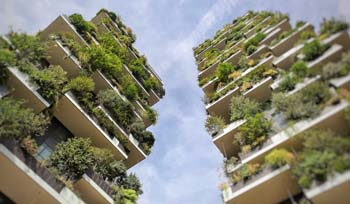Busy cities are often referred to as “urban jungles”, but one of Milan’s modern high-rises gives a whole new meaning to this popular idiom thanks to some uncommon landscaping. In 2014, Italian architect Stefano Boeri unveiled his latest design in Milan’s rising Porta Nuova district; a skyscraper called Bosco Verticale. In English, Bosco Verticale means Vertical Forest, which is an appropriate name considering the construction is composed of two towers that between them incorporate more than 1,000 varieties of plants, shrubs, and trees. The buildings were born out of an ambitious and environmentally noble idea: creating sustainable living spaces that not only foster the natural environment of the city, but regenerate it.
 Bosco Verticale’s two towers are of differing heights with the tallest measuring 360 feet and the shortest measuring 260 feet. Staggered balconies extend from every side of the towers to suspend 780 trees and 14,000 plants over the city. Each of the 113 living spaces in the complex includes a private garden with vegetation that not only serves to absorb carbon dioxide, but also to protect the space from dust particles, direct sunlight, harsh winds, and acoustic pollution. In addition, the views from the apartments are spectacular, providing panoramas of Milan, the outskirts of the city, and even the momentous Alps in the distance.
Bosco Verticale’s two towers are of differing heights with the tallest measuring 360 feet and the shortest measuring 260 feet. Staggered balconies extend from every side of the towers to suspend 780 trees and 14,000 plants over the city. Each of the 113 living spaces in the complex includes a private garden with vegetation that not only serves to absorb carbon dioxide, but also to protect the space from dust particles, direct sunlight, harsh winds, and acoustic pollution. In addition, the views from the apartments are spectacular, providing panoramas of Milan, the outskirts of the city, and even the momentous Alps in the distance.
The location of the towers in the Porta Nuova district, near the center of Milan, is not a coincidence. The project aims not only to regenerate the Porta Nuova district, but to shift the planning of Milan’s city center towards a greener future. To aid in this vision, the parking areas for Bosco Verticale have been constructed underground in favor of a pedestrian and cycling area above them that spans 40 acres and features additional vegetation and public spaces. The location of the towers near normal skyscrapers also helps to aesthetically revolutionize the city’s skyline. Not only do the trees and plants of Bosco Verticale stand out amongst the city’s sea of grey, but their visual impact is dynamic; as the seasons change, so too will the buildings since the vegetation will adopt the distinct colors of each season.
Bosco Verticale won the International High-rise Award in 2014, an honor that recognizes the world’s most innovative and sustainable high-rises, which is granted every two years by the city of Frankfurt in conjunction with the German Architecture Museum. The Bosco Verticale design aims to be a new standard for sustainable buildings not only in Italy but throughout the world. Recently, Stefano Boeri announced that another tower in the style of Bosco Verticale, but with cedar trees, will be constructed in Lausanne, Switzerland. Currently, there are no plans to implement the design in other parts of Italy, but Parma, Siena, and Bolzano (considered to be three of Italy’s greenest cities) could be perfect candidates for the expansion of this architectural and environmental innovation.